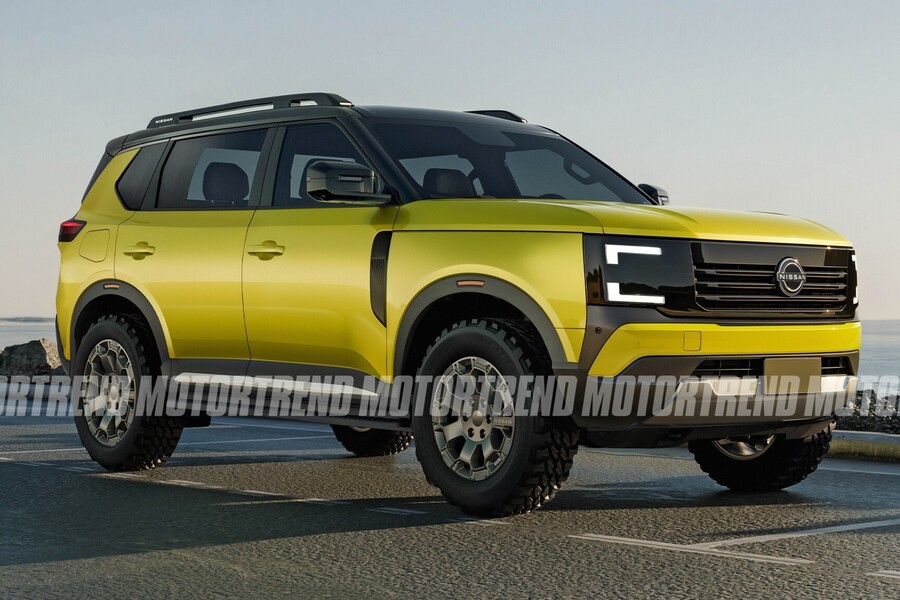Nissan is “very actively” studying a revival of its Xterra nameplate as a compact, off-road-focused SUV—likely electric—after filing a new U.S. trademark and teasing a boxy silhouette with roof rails that Xterra fans will recognize. While the company hasn’t confirmed the badge, Nissan chief planning officer Ponz Pandikuthira told Autoblog the concept is under serious review, even as shifting incentives, tariffs, and internal cost cuts complicate timing. Plans initially floated for a 2027 on-sale date have slipped to late 2028, with a closely related Infiniti coupe-style EV now eyed for roughly a year after that.
Why it matters:
Nissan’s lineup could use more enthusiast-friendly vehicles at a time when rugged SUVs are having a moment. A modern Xterra would reenter a segment reinvigorated by the Ford Bronco and a resurgent Toyota Land Cruiser/4Runner duo—giving Nissan a high-identity off-road entry to pull in new buyers and re-energize brand loyalists.
Background: A Name with Trail Cred
Sold from 2000 to 2015, the original Xterra carved out a niche as a durable, straightforward adventure rig and took home MotorTrend’s 2000 Truck of the Year award. Its formula—practical proportions, visible roof gear, and honest capability—suited buyers who wanted less polish and more purpose. A revival would tap that legacy while signaling that Nissan intends to be part of the current wave of “back-to-basics” off-roaders.
What Nissan Has (Quietly) Teased
Early signals point toward a battery-electric Xterra. The teaser image shows a short front overhang and a long wheelbase—packaging that leaves room for a flat underfloor battery. Nissan had indicated this vehicle would share a platform with a sleeker, coupe-like Infiniti SUV, with both models to be built in Mississippi as Nissan invests heavily to retool that plant for EV production.
Reality Check: Cost-Cutting and Policy Whiplash
Since those initial hints, Nissan has moved to trim complexity by consolidating global platforms and boosting parts commonality. It also canceled a planned EV battery plant in Kyushu, Japan—signs of a company re-scoping its electrification spend. Layer on top the U.S. policy churn around EV incentives and import tariffs, and the business case gets more dynamic. Sources indicate the target launch has shifted from 2027 to late 2028, with Infiniti’s sibling likely trailing by about a year.
In short, Nissan appears to be pausing for better clarity on U.S. rules, costs, and consumer demand before locking in a go-to-market plan.
Two Pathways: Electric First, ICE as a Wild Card
Most likely: All-electric Xterra.
The packaging, plant plans, and Infiniti tie-up still point toward an EV as the default path. A compact, off-road-capable electric SUV with good ground clearance, torque-rich motors, and a robust battery-protection strategy could appeal globally—even if U.S. policy makes the near-term maths harder.
Long-shot but tantalizing: Body-on-frame, ICE-powered Xterra.
If Nissan pivots from some EV nameplates, one scenario is a return to roots: a ladder-frame SUV based on the Frontier pickup, built in the U.S. This would minimize platform proliferation, slot directly against Bronco and Land Cruiser, and sidestep parts of the tariff/tax tangle. The trade-off is a narrower appeal beyond North America and a product that swims upstream in tightening emissions regimes.
The Competitive Picture
- Direct analogs: Ford Bronco, Toyota Land Cruiser/4Runner—both riding strong demand for heritage-styled, trail-ready SUVs.
- EV-adjacent inspirations: While not head-to-head, successes and stumbles among adventure-bent EVs will inform Nissan’s calculus (e.g., consumer expectations around range, charging access near trailheads, and accessory ecosystems).
Production and Platform Notes
- Where: Mississippi remains the logical site if the EV program proceeds as previewed, given the retooling already underway.
- Shared architecture: The Infiniti coupe-like SUV would share core underpinnings, spreading development cost—an important lever amid platform consolidation.
- Timing: Internal targets now point to late 2028 for Xterra (EV), ~2029 for the Infiniti sibling—subject to change as policies and costs evolve.
Key Questions Readers Have (User-Intent Answers)
Is the new Xterra confirmed?
Not officially. But Nissan has filed a U.S. trademark for “Xterra,” teased a boxy SUV silhouette, and its planning chief says a revival is under active consideration—strong smoke, if not fire.
Will it be electric?
That’s the leading scenario. The proportions in Nissan’s teaser and the plan to share a platform with an Infiniti EV support a battery-electric Xterra. A body-on-frame, Frontier-based ICE model remains an outside possibility if Nissan reshuffles its EV slate.
When would it arrive?
The internal working window has slipped from 2027 to late 2028, with the related Infiniti model about a year later. Expect further schedule tuning as Nissan reacts to costs, supply chains, and U.S. policy.
Where would it be built?
Mississippi is the likely home if the EV program proceeds, aligning with Nissan’s U.S. retooling efforts. A hypothetical Frontier-based ICE version would also benefit from U.S. assembly.
Why is policy such a big factor?
Rapid changes to EV incentives, eligibility rules, and tariffs materially affect pricing, profitability, and supplier footprints. Automakers are revisiting launch mixes and timelines to avoid locking into unfavorable economics.
How would it fit the market?
A revived Xterra would give Nissan a credible entrant in the thriving off-road space. If electric, it could test whether adventure buyers are ready for torque-rich, low-range-friendly EVs with rugged styling; if ICE, it would go toe-to-toe with segment stalwarts on familiar terms.
Bottom Line
Nissan appears serious about bringing back the Xterra, with the strongest signals pointing to a compact off-road EV sharing bones with a future Infiniti. But the company is also pruning platforms and watching U.S. policy closely, which has likely pushed the timeline to the back half of 2028. A back-to-basics, Frontier-based ICE Xterra remains a credible fallback if the EV business case weakens. Either way, the logic is clear: a modern Xterra could inject personality into Nissan’s lineup and meet surging demand for trail-ready SUVs—provided the numbers add up when the green light finally comes.

